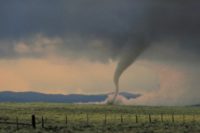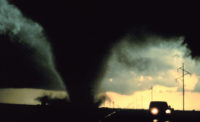Ensuring worker safety on the job is a critical component of running any successful business. The task becomes a substantially larger challenge when your business model includes numerous itinerant employees moving around to various job sites across a region or across the country. Numerous industries find themselves in this position, from companies based in oil production to agriculture to telecommunication services.
For many of these companies, employees are not just moving around to different areas with some regularity, but they are also working in difficult outdoor environments. This means their safety is often subject not only to the demands of the job, but to unfavorable weather patterns throughout the year. During severe weather, especially, work out in the elements can be dangerous at best.
In these situations, it becomes paramount that companies have already thought through and provided a plan of action for employees. Clear guidance and alerts during extreme weather events or any dangerous weather conditions can help employees make the safest decisions and keep operations moving efficiently and effectively. Developing this guidance is an important component of any safety plan.
Extreme weather factors
Extreme weather comes in all shapes and sizes including big thunderstorms, blustery winds, extreme cold, or flooding. Each one of these weather events may call for a different plan of action to keep employees safe. Coming up with a working plan for every weather condition employees could be exposed to is valuable, especially if there are differences in how they should respond.
There may well be different responses as certain types of jobs may make employees more at risk of some weather events than others. For example, employees working on telephone lines or at industrial sites may be more at risk in windy conditions than in cold conditions. It would likely be important to distinguish between the two in any safety protocols and coordination efforts for field-based employees.
Certain parts of the job may also require different responses. For instance, employees moving between job sites need to take into account the likelihood that they will drive in poor weather conditions. A safety protocol may include safe driving strategies during a storm such as making sure headlights are on, slowing down below speed limits, and, in wintery weather conditions, avoiding the use of cruise control in case there is black ice present on roadways.
Develop a plan
The big thing that company leaders need to focus on is developing general guidelines for how business should be conducted in poor weather conditions — a premortem brainstorm, if you will. Taking the time to think about all of the things that could go wrong and how employees should respond to them is the best way to ensure they take appropriate actions when these situations do come up. Having a clear plan makes all the difference.
This plan should include both flexibility and rigid thresholds. It should be clear that employees are responsible for assessing the risks, including weather, before beginning a task. All employees should have the flexibility to determine if they believe the weather is too bad to work safely in. However, there should also be clear guidelines and thresholds built into a plan explaining when the company requires employees to stop work.
For example, the company may allow employees to determine whether or not they feel safe working during some thunderstorms. However, the protocol may also state that if the thunderstorm can be classified as severe, all work must come to a stop. Clear thresholds for defining a severe thunderstorm might include things like:
- Hail that is greater than one inch
- Wind gusts exceeding 50 knots
- Tornado warnings
- Lightning within a certain distance of work activities
One major factor that some employees may deal with is underestimating how severe a storm might be. In this situation, it is imperative that companies have a plan in place to reach employees and let them know to take cover. In some situations, this can be as easy as a quick cell phone call, but in others it might mean a plan for regular check-ins or having somebody nearby reach the crew.
Crew members should also be equipped with alternative means of communication such as CB radios in case they lose cell service, and they should know which radio station to monitor as severe weather develops.
When to implement the plan
Defining when a plan should be implemented is an important step, but it is also necessary to spell out what the protocol is when it comes time to actually implement a safety plan. In certain conditions, should employees take the time to make sure pieces of equipment are secured and ready to weather out a severe storm? Or should they drop everything and take cover without worrying about equipment?
It also pays to work with employees to make sure they are familiar with how the plan should be implemented. A safety plan is only worthwhile if employees know how to implement it, right? At a minimum safety plan protocols should be discussed annually at company meetings. And opportunities to practice these protocols in non-emergency situations should be made available to both new and seasoned employees on a semi-regular basis.
Company leaders should also strive to create a culture of safety in the workplace. Creating a space where employees feel as though they can discuss safety concerns can be a challenge, but it is valuable to strive for that goal. If leadership doesn’t emphasize safety, many employees may start to feel as though it is OK for them to skimp on some of the safety protocols such as by not wearing appropriate personal protective equipment.
Lastly, but certainly not least, is the concern that some employees may experience job-related mental health problems, which can slow down their response in the field. Researchers estimate that a mental wellness issue such as depression can impair your physical ability to complete tasks by as much as 20%. Therefore, employers must encourage itinerant employees to be transparent about their mental health. Then, an employee with a disorder or concern can be referred to a therapist for telehealth or in-person appointments to help them establish a set of coping skills for emergencies.
Itinerant employees who work outside in varying weather conditions can have a number of unique safety concerns. As the company works to develop appropriate safety protocols for severe weather, it is important to ensure that employees are provided with clear guidance and thresholds for when to implement protocols. Doing so can work to ensure safety remains a top company priority.


